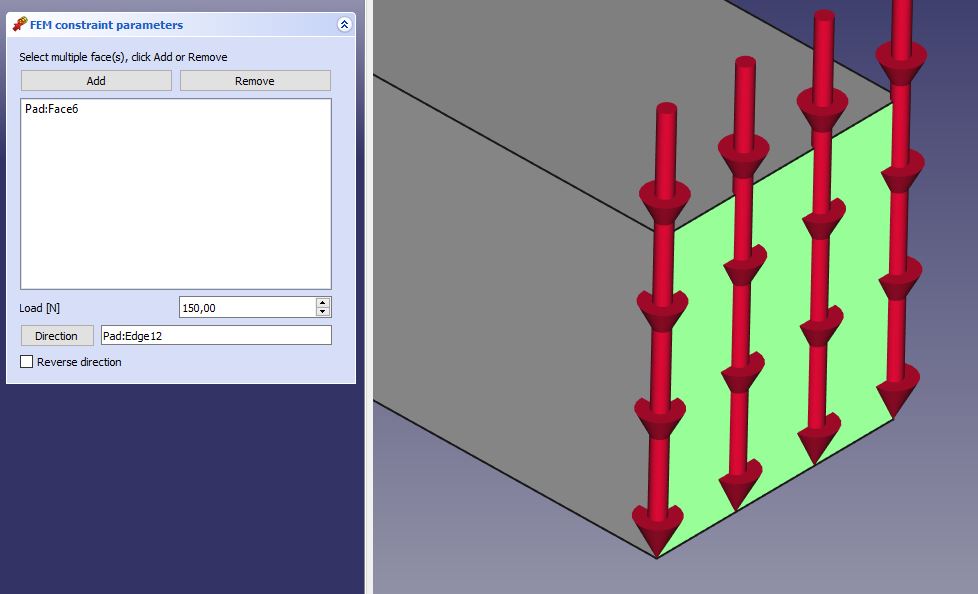FEM ConstraintForce/pl: Difference between revisions
(Updating to match new version of source page) |
(Updating to match new version of source page) |
||
| Line 12: | Line 12: | ||
{{GuiCommand |
{{GuiCommand |
||
|Name=FEM ConstraintForce |
|Name=FEM ConstraintForce |
||
|MenuLocation=Model → Mechanical |
|MenuLocation=Model → Mechanical boundary conditions and loads → Constraint force |
||
|Workbenches=[[FEM_Workbench|FEM]] |
|Workbenches=[[FEM_Workbench|FEM]] |
||
|SeeAlso=[[FEM_ConstraintPressure|FEM ConstraintPressure]] |
|SeeAlso=[[FEM_ConstraintPressure|FEM ConstraintPressure]] |
||
| Line 23: | Line 23: | ||
==Usage== |
==Usage== |
||
# There are several ways to invoke the command |
# There are several ways to invoke the command: |
||
#* |
#* Press the {{Button|[[Image:FEM_ConstraintForce.svg|16px]] [[FEM ConstraintForce|FEM Constraint force]]}} button |
||
#* Select the {{MenuCommand|Model → Mechanical |
#* Select the {{MenuCommand|Model → Mechanical boundary conditions and loads → [[Image:FEM ConstraintForce.svg|16px]] Constraint force}} option from the menu. |
||
# If you have Mesh displayed, you need to hide it (select the mesh object and press {{ |
# If you have Mesh displayed, you need to hide it (select the mesh object and press {{KEY|spacebar}} or right-click and select {{MenuCommand|Hide item}}) and show the original model. |
||
# Click on a ''face'', ''line'' or ''point'' to which a force should be applied. The object will appear in the list of geometrical objects. |
# Click on a ''face'', ''line'' or ''point'' to which a force should be applied. The object will appear in the list of geometrical objects. |
||
# Fill in {{ |
# Fill in {{MenuCommand|Load [N]}} with a force value in [N]. |
||
# {{ |
# {{MenuCommand|Direction}}: In a typical case, you'll leave this field empty to apply a force in the normal direction. You can revert the direction of the force by clicking {{Button|Reverse direction}}. In other cases, you need to pick a face/plane or edge, which serves as reference for force direction. |
||
# Click {{Button|OK}} to finish |
# Click {{Button|OK}} to finish. |
||
[[File:FEM ConstraintForce example.JPG]] |
[[File:FEM ConstraintForce example.JPG]] |
||
Revision as of 14:00, 30 September 2023
|
|
| Menu location |
|---|
| Model → Mechanical boundary conditions and loads → Constraint force |
| Workbenches |
| FEM |
| Default shortcut |
| None |
| Introduced in version |
| - |
| See also |
| FEM ConstraintPressure |
Description
Applies a force of a given value [N] to the selected geometry.
Usage
- There are several ways to invoke the command:
- Press the
FEM Constraint force button
- Select the Model → Mechanical boundary conditions and loads →
Constraint force option from the menu.
- Press the
- If you have Mesh displayed, you need to hide it (select the mesh object and press spacebar or right-click and select Hide item) and show the original model.
- Click on a face, line or point to which a force should be applied. The object will appear in the list of geometrical objects.
- Fill in Load [N] with a force value in [N].
- Direction: In a typical case, you'll leave this field empty to apply a force in the normal direction. You can revert the direction of the force by clicking Reverse direction. In other cases, you need to pick a face/plane or edge, which serves as reference for force direction.
- Click OK to finish.
Notes
- The defined force is applied uniformly to the selected objects. For example, if you define one force constraint with 200 N applied to two faces having the same area, each face will be uniformly loaded with 100 N.
- Materiał: Bryła, Ciecz, Nieliniowy materiał mechaniczny, Materiał zbrojony (beton), Edytor materiału
- Geometria elementu: Geometria elementu, Obrót w okół osi, Geometria elementu 2D, Element przepływu
Wiązania
- Elektromagnetyczne: Potencjał elektryczny, Gęstość prądu, Magnetyzacja
- Geometryczne: Obrót w płaszczyźnie, Zapis wyników z przekroju, Zdefiniuj odkształcenie
- Mechaniczne: Zdefiniuj przytwierdzenie, Zdefiniuj przemieszczenie, Zdefiniuj kontakt, Zdefiniuj powiązanie, Wiązanie sprężyny, Zdefiniuj siłę, Zdefiniuj obciążenie ciśnieniem, Zdefiniuj siłę odśrodkową, Zdefiniuj obciążenie ciężarem własnym
- Termiczne: Warunek początkowy temperatury, Zdefiniuj strumień ciepła, Zdefiniuj temperaturę, Zdefiniuj objętościowe źródło ciepła
- Zmieniające wiązania: Zdefiniuj przenikalność elektryczną próżni
- Siatki: Siatka Netgen, Siatka GMSH, Warstwa graniczna siatki, Obszar siatki, Grupa siatki, Utwórz zestaw węzłów, Siatka MES na obiekt środowiska Siatka
- Solver: Narzędzia CalculiX, Elmer, Mystran, Z88; Równania: Elastyczności, Elektrostatyczne, Siły elektrostatycznej, Magnetodynamiczne, RMagnetodynamiczne 2D, Przepływu, Strumienia, Ciepła; Solver: Kontrola pracy solvera, Uruchom solver
- Wyniki: Oczyszczanie z wyników, Prezentacja wyników; Postprocessing: Zastosuj zmiany, Prezentacja graficzna, Filtr rozpraszający, Skalarny filtr obcinający, Filtr odcięcia funkcji, Filtr odcięcia obszaru, Filtr konturów, Filtr danych wzdłuż linii, Wykres liniowości naprężeń, Filtr obcinania danych w punkcie, Utwórz funkcję, Filtr funkcji płaszczyzny, Filtr funkcji sfery, Filtr funkcji walca, Filtr funkcji prostopadłościanu
- Dodatkowe: Konfiguracja, Instalacja środowiska MES, Siatka, FEM Solver, CalculiX, Beton, Rodzaje elementów
- Jak zacząć
- Instalacja: Pobieranie programu, Windows, Linux, Mac, Dodatkowych komponentów, Docker, AppImage, Ubuntu Snap
- Podstawy: Informacje na temat FreeCAD, Interfejs użytkownika, Profil nawigacji myszką, Metody wyboru, Nazwa obiektu, Edytor ustawień, Środowiska pracy, Struktura dokumentu, Właściwości, Pomóż w rozwoju FreeCAD, Dotacje
- Pomoc: Poradniki, Wideo poradniki
- Środowiska pracy: Strona Startowa, Architektura, Assembly, CAM, Rysunek Roboczy, MES, Inspekcja, Siatka, OpenSCAD, Część, Projekt Części, Punkty, Inżynieria Wsteczna, Robot, Szkicownik, Arkusz Kalkulacyjny, Powierzchnia 3D, Rysunek Techniczny, Test Framework
